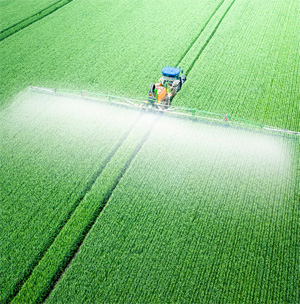How Prevalent And Dangerous Is Pesticide Contamination?
By Miguel Leyva

Add pesticides to the list of contaminants that are prevalent in U.S. drinking water and can cause severe health impacts, including cancer and Parkinson’s disease.
Unfortunately, there is a myriad of toxic agents that can lead to drinking water contamination, from heavy metals such as lead and arsenic to chemicals such as per- and polyfluoroalkyl substances (PFAS), which have recently garnered much attention. However, pesticides are contaminants that few people imagine lurking in their drinking water. The term “pesticides” encompasses all substances whose purpose is to control pests, and they can be herbicides, insecticides, rodenticides, fungicides, and many others. Pesticides have a crucial role in food production as they protect yields and increase the number of times a crop can be grown on the same land.
Over 1 billion pounds of pesticides are used across the United States every year. America ranks second after China1 when it comes to countries that employ the largest amounts of pesticides. Pesticides are currently used on 900,000 farms and in 70 million households in the U.S.2 While 75% of pesticides are involved in agriculture, 85% of American households have at least one pesticide in storage, and 63% of families have one to five pesticides at home. Pesticide use in the country has grown because not only must the ever-increasing population be supplied with food, but crops and food need to be grown for export, too.
While pesticides are very effective in keeping weeds, insects, and rodents at bay, they are extremely harmful to our health. Exposure to pesticides, whether direct or indirect, can lead to numerous terrible, debilitating conditions and diseases over the years.
Indirect pesticide exposure occurs by drinking or cooking with contaminated water. For instance, glyphosate, a dangerous and highly toxic herbicide popular in the U.S., is very soluble in water, at 1.01 grams per 100 milliliters. Therefore, boiling alone cannot remove glyphosate from drinking water. Pesticides that are applied to farmlands, lawns, and gardens can easily make their way into groundwater, as well as surface water systems that feed drinking water supplies. Pesticides lurk in up to 41% of supply wells3 that provide households with drinking water.
How Do Pesticides End Up In Drinking Water?
Before reaching municipal water systems, pesticides first contaminate groundwater, as the soil they permeate facilitates this process. Pesticide contamination of groundwater is a very serious subject, since groundwater is used for drinking water by roughly 50% of America’s population.4 This is a great concern for people who live in the agricultural areas where pesticides are most often used. In fact, a whopping 95% of this demographic relies exclusively on groundwater for drinking water.5
Pesticides enter the hydrologic system from point and nonpoint sources like most water contaminants. The former are specific release points, such as pesticide manufacturing plants, whereas the latter are diffuse and widely dispersed. Nonpoint sources are the dominant ones for pesticides found in streams and groundwater. These include runoff to streams from agricultural and urban land, deposition of pesticides from the atmosphere, and seepage to groundwater in areas where pesticides are used.
There are plenty of factors affecting groundwater contamination with pesticides, such as the pesticide itself. This refers to the active ingredients, the additives mixed with the active ingredients, and how long it takes for the pesticide to break down. Other factors include the pesticide’s mobility in soil, whether the pesticide is soluble in water, microbial activity, soil temperature, and irrigation management. Irrigation heightens the chance that the pesticide will migrate to groundwater and surface water. Irrigating at a speed exceeding the soil’s infiltration rate will result in runoff that carries the pesticide with it.
Consequently, because pesticides can easily make their way into groundwater, which is the primary source of drinking water for many people, surface water systems that feed drinking water supplies most likely contain pesticides. In the U.S., approximately 15% of the population (about 43 million people)6 relies on water from their private wells, but these are not regulated under the Safe Drinking Water Act (SDWA).
What Are The Health Consequences?
 The health effects of pesticide exposure depend on what substance an individual has been ingesting. Two of the most common pesticides in drinking water are atrazine and simazine. Both are regulated and have maximum limits — 3 ppb for atrazine and 2 ppb for simazine. Nonetheless, there are a lot of other pesticides present in drinking water that are not regulated. This is a serious cause for concern. There are thousands of chemicals being washed into U.S. waterways. This includes many pesticides, out of which only 100 are monitored and regulated by the U.S. EPA.7
The health effects of pesticide exposure depend on what substance an individual has been ingesting. Two of the most common pesticides in drinking water are atrazine and simazine. Both are regulated and have maximum limits — 3 ppb for atrazine and 2 ppb for simazine. Nonetheless, there are a lot of other pesticides present in drinking water that are not regulated. This is a serious cause for concern. There are thousands of chemicals being washed into U.S. waterways. This includes many pesticides, out of which only 100 are monitored and regulated by the U.S. EPA.7
Usually, it takes several years of mild to severe exposure to pesticides for an individual to manifest disease. The level of contamination that poses a risk to human health ultimately depends on the toxicity of the pesticides, the amount present in the water, and the extent of exposure that occurs daily when using contaminated drinking water.
Among the unhealthy conditions and diseases, contamination with pesticides causes neurotoxicity, cancer, and Parkinson’s disease. The pesticide notorious for causing the latter disease is paraquat, one of the most prevalent in the United States. Farmers in America use over 8 million pounds of paraquat annually on crops such as peanuts, wheat, citrus, soy, corn, almonds, garlic, pears, grapes, and strawberries. Paraquat is soluble in water and is most likely to contaminate drinking water when used together with atrazine or simazine. Still, it can end up in drinking water by itself as well.
Paraquat exposure causes Parkinson’s disease8 by damaging the brain region that releases dopamine, medically known as substantia nigra. Dopamine is one of the neurotransmitters in our bodies responsible for sending messages to the area of the brain that controls movement and coordination, among others. In people with Parkinson’s disease, movement and coordination are severely affected, these symptoms being hallmarks of the disorder. Sadly, Parkinson’s disease is irreversible, has no cure, and the symptoms typically worsen over the years.
How Can This Issue Be Minimized?
The EPA has drinking water regulations for about 100 contaminants, including pesticides, and the SDWA includes a process that the EPA must follow to identify and regulate new contaminants. Concerning pesticides and other drinking water contaminants, the EPA’s responsibility is to set legal limits for these as the contaminants’ occurrences in drinking water cannot be avoided entirely.
Although the EPA monitors and regulates dozens of drinking water contaminants, many pesticides are not regulated. While municipal water systems treat drinking water with chlorine to kill bacteria and viruses, this substance removes only 60% of the pesticides present in the water.
Combining oxidation by chlorine with a coagulation-flocculation-decantation process is more effective in getting rid of pesticides from drinking water. Individuals can make the water in their household safer to drink and cook with by using charcoal filters and reverse osmosis (RO) treatments. Water filters are a good option to remove pesticides, at least partially. They are easy to use and relatively inexpensive. RO treatment that entails activated carbon filters supposedly removes between 97% and 99% of all pesticides, insecticides, and herbicides from drinking water.
References:
- https://www.worldometers.info/food-agriculture/pesticides-by-country/
- https://people.forestry.oregonstate.edu/steve-strauss/sites/people.forestry.oregonstate.edu.steve-strauss/files/PestUse1996.pdf
- https://beyondpesticides.org/dailynewsblog/2021/01/millions-of-peopledrinking-groundwater-with-pesticides-or-pesticide-degradates/
- https://www.usgs.gov/news/featured-story/quality-nations-groundwaterprogress-national-survey
- https://www.usgs.gov/special-topics/water-science-school/science/pesticidesgroundwater
- https://www.usgs.gov/mission-areas/water-resources/science/domestic-privatesupply-wells
- https://www.washingtonpost.com/national/health-science/in-us-drinkingwater-many-chemicals-are-regulated--but-many-arent/2016/06/09/e48683bc-21b9-11e6-aa84-42391ba52c91_story.html
- https://www.atraxialaw.com/news/does-paraquat-exposure-cause-parkinsonsdisease/
 About The Author
About The Author
As the case manager at Atraxia Law, Miguel Leyva specializes in gathering and organizing the information about paraquat exposure and Parkinson’s disease he receives from people whose health was affected by pesticides. He also supports agricultural workers and their families in defending their injury claims filed with paraquat manufacturers.
